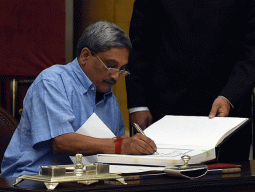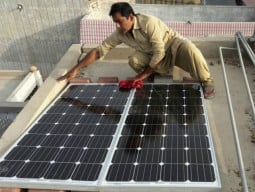
Not a single passenger has passed through the gates of an airport big enough to handle more than 300,000 travellers a year, with parking bays for three 180-seater narrow-body jets.
Read: Indian activist claims Modi government 'vendetta'
 A dog walks past the main entrance of the Jaisalmer Airport in desert state of Rajasthan, India, August 13, 2015. PHOTO: REUTERS
A dog walks past the main entrance of the Jaisalmer Airport in desert state of Rajasthan, India, August 13, 2015. PHOTO: REUTERSIndia has spent more than $50 million since 2009 on eight airports that do not receive scheduled flights — white elephants that are a reminder of the pitfalls for Prime Minister Narendra Modi as he bets on an infrastructure drive to fuel growth.
India's main hubs, meanwhile, are bursting at the seams, slowing airlines' ability to expand in a vast country where they should be supporting economic growth.
 Bones of dead animals lie in a road outside the Jaisalmer Airport in desert state of Rajasthan, India, August 13, 2015. PHOTO: REUTERS
Bones of dead animals lie in a road outside the Jaisalmer Airport in desert state of Rajasthan, India, August 13, 2015. PHOTO: REUTERS"They (the government) need to realise it's not a case of 'build the airport and we will come'," said Sanjiv Kapoor, chief operating officer at SpiceJet Ltd. The private sector airline last year ceased flying to a new airport in the city of Mysore because of insufficient demand.
India's ghost terminals were built largely by the previous government, which planned 200 'no frills' airports, encouraged by rising air travel and the need to connect far-flung regions.
 Dust covered seats are pictured inside the lounge of the Jaisalmer Airport in desert state of Rajasthan, India, August 13, 2015. PHOTO: REUTERS
Dust covered seats are pictured inside the lounge of the Jaisalmer Airport in desert state of Rajasthan, India, August 13, 2015. PHOTO: REUTERSBut the empty check-in desks and cavernous baggage halls highlight the risks for Modi, too, of catering to powerful regional bosses and spending without a unifying strategy.
China's investment splurge has left dozens of similar ghost projects.
 Buildings are reflected in a puddle after rains inside the premises of the Jaisalmer Airport in desert state of Rajasthan, India, August 13, 2015. PHOTO: REUTERS
Buildings are reflected in a puddle after rains inside the premises of the Jaisalmer Airport in desert state of Rajasthan, India, August 13, 2015. PHOTO: REUTERSThe civil aviation ministry declined to comment on whether Modi's government would stick with the 200 airport growth plan. But the incentive to grow in less-developed regions remains: on Tuesday, Modi pledged 27 billion rupees ($413 million) for four new airports in the impoverished state of Bihar, which holds elections this year.
Read: India's Modi to perform yoga at mass public event
 Basins are pictured in a washroom inside the Jaisalmer Airport in desert state of Rajasthan, India, August 13, 2015. PHOTO: REUTERS
Basins are pictured in a washroom inside the Jaisalmer Airport in desert state of Rajasthan, India, August 13, 2015. PHOTO: REUTERS"The AAI (Airports Authority of India) has invested in some airports without any economic logic," said Kapil Kaul, Delhi-based chief executive at consultancy Centre for Aviation (CAPA).
"Every state government wants to have a big airport, but you have to look at it from a national perspective and say where do we need airports, where is the demand and the growth coming from?" he said.
 A baggage carousel is pictured inside the Jaisalmer Airport in desert state of Rajasthan, India, August 13, 2015. PHOTO: REUTERS
A baggage carousel is pictured inside the Jaisalmer Airport in desert state of Rajasthan, India, August 13, 2015. PHOTO: REUTERSAcross India, more than half of the 100-odd domestic-only airports operated by AAI have not seen a scheduled flight this year, official data shows, though some are older airports designed primarily for chartered planes.
 Baggage trolleys are seen at the Jaisalmer Airport in desert state of Rajasthan, India, August 13, 2015. PHOTO: REUTERS
Baggage trolleys are seen at the Jaisalmer Airport in desert state of Rajasthan, India, August 13, 2015. PHOTO: REUTERSThe AAI did not respond to requests for comment.
More pigeons than people
The rush to build comes as passenger numbers grow 20 per cent a year, to 38.8 million in the first half of 2015, leaving India's major airports, which account for four-fifths of traffic, saturated.
Plans for a second hub in financial capital Mumbai are years behind schedule while the government has struggled to privatise four large airports to fund their expansion.
 A milestone is seen outside the Jaisalmer Airport in desert state of Rajasthan, India, August 13, 2015. PHOTO: REUTERS
A milestone is seen outside the Jaisalmer Airport in desert state of Rajasthan, India, August 13, 2015. PHOTO: REUTERSThis means airlines cannot widen their networks to places like Jaisalmer dependent on feeder traffic from the gateways.
In the huge sunlit expanse of Jaisalmer's new arrivals lounge, two disused baggage conveyor belts gathered dust last week as pigeons nested in the roof. A group of cleaners sat next to the taxiway listening to music on their mobile phones.
"You should come here on your own. It's scary," said the airport's chief engineer.
Read: A taxi in India will transport you to Pakistan and back
SK Singh, the local AAI director, defended the airport, saying Jaisalmer — famed for its huge sand-coloured 12th century fort — has a growing tourist industry, and the nearest functioning airport is 290 km away.
 A security guard walks outside the arrival lounges at the Jaisalmer Airport in desert state of Rajasthan, India, August 13, 2015. PHOTO: REUTERS
A security guard walks outside the arrival lounges at the Jaisalmer Airport in desert state of Rajasthan, India, August 13, 2015. PHOTO: REUTERSAirlines are not so sure. SpiceJet's Kapoor said demand was linked to Jaisalmer's cooler winter months, making it tough to lure enough passengers. Officials at GoAir and IndiGo said they had no plans to start flights.
Analysts said the government would need to cut landing charges or provide funding to entice carriers.
 A signboard is seen outside the Jaisalmer Airport in desert state of Rajasthan, India, August 13, 2015. PHOTO: REUTERS
A signboard is seen outside the Jaisalmer Airport in desert state of Rajasthan, India, August 13, 2015. PHOTO: REUTERS"If that too doesn't work, it's better to lock up the airport and redeploy staff," said Amber Dubey, an aviation expert at KPMG.












































COMMENTS (1)
Comments are moderated and generally will be posted if they are on-topic and not abusive.
For more information, please see our Comments FAQ